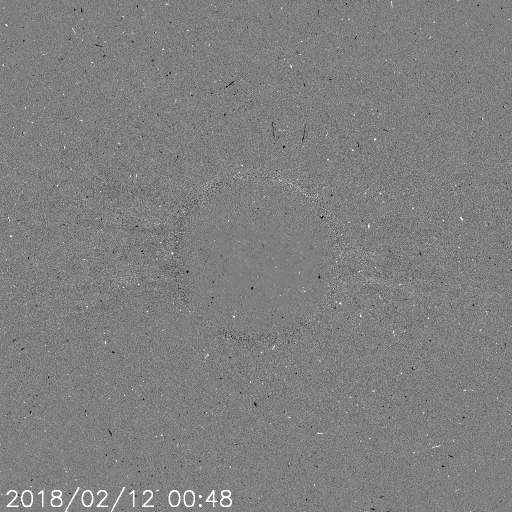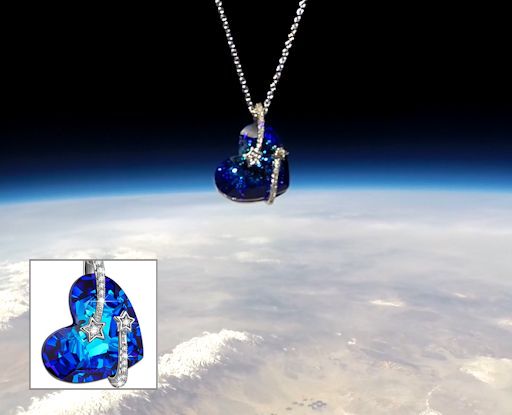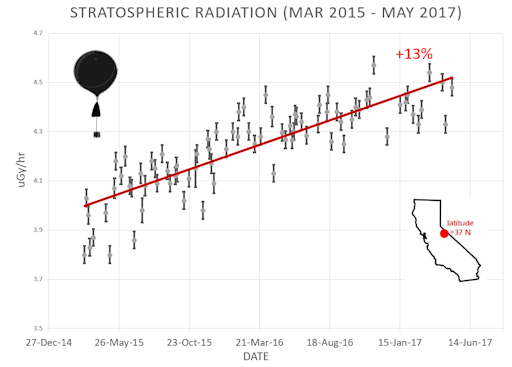All-inclusive Northern Lights trips in Tromsø, Norway. Small groups, big experiences! Highly qualified guides ensure unique and unforgettable adventures with a personal touch. Visit Explore the Arctic | | |
SUBSIDING CHANCE OF FLARES: Sunspot AR2699 has begun to decay, losing almost half of its area in the past ~24 hours. As a result, the chance of solar flares is subsiding. NOAA forecasters say there is only a 10% chance of M-flares and no more than a 1% chance of X-flares on Feb. 14th. Free: Solar Flare Alerts
SUNSPOT EXPLODES, HURLS CME AT EARTH: On Feb. 12th, the magnetic canopy of sunspot AR2699 exploded--for more than 6 hours. The slow-motion blast produced a C1-class solar flare and hurled a coronal mass ejection (CME) almost directly toward Earth. This movie from the Solar and Heliospheric Observtory (SOHO) shows the CME leaving the sun:

The CME could arrive as early as Feb. 14th, although Feb 15th is more likely. NOAA forecasters say there is a 60% chance of G1-class geomagnetic storms with isolated periods of stronger G2 storming.
The effectiveness of the CME could be enhanced by a stream of solar wind that was already en route to Earth when the sunspot exploded. The solar wind is flowing from a large wedge-shaped hole in the sun's atmosphere. If the approaching CME sweeps up material from that stream, snowplow-style, it could strike Earth's magnetic field with extra mass and potency.
Arctic sky watchers should be alert for auroras when the CME arrives. If the coming storm intensifies to category G2, observers in northern-tier US states from Maine to Washington could see auroras as well. Stay tuned for updates. Free: Aurora Alerts
Realtime Space Weather Photo Gallery
IT'S VALENTINE'S DAY! Did you forget to buy a Valentine's gift? Prediction: Your sweetheart will forgive the oversight if she receives this:

Nothing says "I love you" like a space pendant, and you can have one for $199.95.
The students of Earth to Sky Calculus flew a payload-full of these heart-shaped Venus pendants to the stratosphere onboard a high-altitude helium balloon. The one pictured above is floating 110,550 ft above the Sierra of Centrl California.
With a sterling silver backface that says "I Love You to the Moon and Back," these blue jewels make great Valentine's, Mother's Day, and birthday gifts. Each pendant comes with a greeting card showing the jewelry in flight and telling the story of its journey to the stratosphere and back again. Sales of this pendant support the Earth to Sky Calculus cosmic ray ballooning program and hands-on STEM research.
Far Out Gifts: Earth to Sky Store
All proceeds support hands-on STEM education
A BACKFLIP, WITH ATMOSPHERIC OPTICS: Last week, photographer Göran Strand set up his camera at the Åre ski resort in Sweden. His goal: To catch a skier performing a backflip. He succeeded in that and more. In the icy air behind the flying athlete he also recorded a bright subsun:

"This is my first ever backflip-subsun combo," says Strand. "A lucky catch!"
The subsun is a reflection of the actual sun from jewel-like ice crystals called "diamond dust." Take a closer look at Strand's photo. You can actually see the individual crystals glinting in the air.
Ski resorts turn out to be an excellent place to see subsuns and other luminous halos around the sun. Atmospheric optics expert Les Cowley explains: "Modern snow blowers are the key. Many use biological material as highly effective nuclei on which the desired snow crystals grow. Near optical perfect halo forming crystals (simple long and short hexagonal prisms) are an unintended by-product. The latter grow very slowly on the nuclei downwind of the blowers."
"I have several colleagues that twenty years or so ago traveled to the South Pole in order to study [complex ice halo] displays," he adds. "Now they travel instead to locations near ski slopes and study the halos at night using artificial suns."
Realtime Aurora Photo Gallery
Every night, a network of
NASA all-sky cameras scans the skies above the United States for meteoritic fireballs. Automated software maintained by NASA's Meteoroid Environment Office calculates their orbits, velocity, penetration depth in Earth's atmosphere and many other characteristics. Daily results are presented here on Spaceweather.com.
On Feb. 14, 2018, the network reported 7 fireballs.
(7 sporadics)

In this diagram of the inner solar system, all of the fireball orbits intersect at a single point--Earth. The orbits are color-coded by velocity, from slow (red) to fast (blue). [Larger image] [movies]
Potentially Hazardous Asteroids (
PHAs) are space rocks larger than approximately 100m that can come closer to Earth than 0.05 AU. None of the known PHAs is on a collision course with our planet, although astronomers are finding
new ones all the time.
On February 14, 2018 there were 1882 potentially hazardous asteroids.
 |
Recent & Upcoming Earth-asteroid encounters: | Asteroid | Date(UT) | Miss Distance | Velocity (km/s) | Diameter (m) |
| 2018 CN2 | 2018-Feb-09 | 0.2 LD | 20.2 | 10 |
| 2018 BL1 | 2018-Feb-09 | 16.5 LD | 20.3 | 76 |
| 2018 CA | 2018-Feb-09 | 19.9 LD | 7.6 | 69 |
| 511684 | 2018-Feb-09 | 12.9 LD | 17.7 | 257 |
| 2018 CB | 2018-Feb-09 | 0.2 LD | 7.3 | 23 |
| 2018 CB2 | 2018-Feb-11 | 6.5 LD | 15.5 | 36 |
| 1991 VG | 2018-Feb-11 | 18.4 LD | 2.1 | 7 |
| 2018 CX | 2018-Feb-11 | 5.7 LD | 11 | 32 |
| 2014 WQ202 | 2018-Feb-11 | 15.1 LD | 19.8 | 62 |
| 2018 CE3 | 2018-Feb-12 | 10.7 LD | 7.2 | 11 |
| 2018 CH2 | 2018-Feb-12 | 2.1 LD | 9.1 | 9 |
| 2018 CL2 | 2018-Feb-13 | 16.3 LD | 13.9 | 25 |
| 2018 CW2 | 2018-Feb-13 | 18.6 LD | 9.4 | 28 |
| 2018 CA2 | 2018-Feb-13 | 10.5 LD | 7.4 | 23 |
| 2018 CR3 | 2018-Feb-13 | 6.8 LD | 20.5 | 26 |
| 2018 CT3 | 2018-Feb-14 | 14.6 LD | 14.8 | 98 |
| 2018 CF3 | 2018-Feb-14 | 11.1 LD | 8.7 | 17 |
| 2018 CS2 | 2018-Feb-14 | 14.8 LD | 5.7 | 28 |
| 2018 CY2 | 2018-Feb-14 | 18.7 LD | 15 | 122 |
| 2018 CU2 | 2018-Feb-15 | 2.2 LD | 8.9 | 9 |
| 2018 CB1 | 2018-Feb-15 | 9.7 LD | 11.4 | 29 |
| 2018 CC1 | 2018-Feb-15 | 14.1 LD | 15.4 | 70 |
| 2018 CD3 | 2018-Feb-15 | 0.9 LD | 7.7 | 7 |
| 2018 CX2 | 2018-Feb-16 | 17.3 LD | 13.9 | 28 |
| 2018 CP2 | 2018-Feb-19 | 6.1 LD | 11.3 | 48 |
| 2018 CJ | 2018-Feb-20 | 9.3 LD | 15.3 | 67 |
| 2016 CO246 | 2018-Feb-22 | 15.3 LD | 5.4 | 21 |
| 2017 DR109 | 2018-Feb-24 | 3.7 LD | 7.4 | 11 |
| 2016 FU12 | 2018-Feb-26 | 13.2 LD | 4.5 | 15 |
| 2014 EY24 | 2018-Feb-27 | 14.8 LD | 8 | 54 |
| 2015 BF511 | 2018-Feb-28 | 11.7 LD | 5.7 | 39 |
| 2003 EM1 | 2018-Mar-07 | 16.6 LD | 8 | 45 |
| 2017 VR12 | 2018-Mar-07 | 3.8 LD | 6.3 | 278 |
| 2018 BK7 | 2018-Mar-09 | 10.2 LD | 8.7 | 69 |
| 2015 DK200 | 2018-Mar-10 | 6.9 LD | 8 | 27 |
| 2016 SR2 | 2018-Mar-28 | 18.7 LD | 7.3 | 20 |
| 2010 GD35 | 2018-Mar-31 | 15.5 LD | 11.6 | 45 |
| 2004 FG29 | 2018-Apr-02 | 4 LD | 14.9 | 22 |
| 363599 | 2018-Apr-12 | 19.3 LD | 24.5 | 224 |
| 2014 UR | 2018-Apr-14 | 9.3 LD | 4.4 | 17 |
Notes: LD means "Lunar Distance." 1 LD = 384,401 km, the distance between Earth and the Moon. 1 LD also equals 0.00256 AU. MAG is the visual magnitude of the asteroid on the date of closest approach. | | Cosmic Rays in the Atmosphere |
Readers, thank you for your patience while we continue to develop this new section of Spaceweather.com. We've been working to streamline our data reduction, allowing us to post results from balloon flights much more rapidly, and we have developed a new data product, shown here:

This plot displays radiation measurements not only in the stratosphere, but also at aviation altitudes. Dose rates are expessed as multiples of sea level. For instance, we see that boarding a plane that flies at 25,000 feet exposes passengers to dose rates ~10x higher than sea level. At 40,000 feet, the multiplier is closer to 50x. These measurements are made by our usual cosmic ray payload as it passes through aviation altitudes en route to the stratosphere over California.
What is this all about? Approximately once a week, Spaceweather.com and the students of Earth to Sky Calculus fly space weather balloons to the stratosphere over California. These balloons are equipped with radiation sensors that detect cosmic rays, a surprisingly "down to Earth" form of space weather. Cosmic rays can seed clouds, trigger lightning, and penetrate commercial airplanes. Furthermore, there are studies ( #1, #2, #3, #4) linking cosmic rays with cardiac arrhythmias and sudden cardiac death in the general population. Our latest measurements show that cosmic rays are intensifying, with an increase of more than 13% since 2015:

Why are cosmic rays intensifying? The main reason is the sun. Solar storm clouds such as coronal mass ejections (CMEs) sweep aside cosmic rays when they pass by Earth. During Solar Maximum, CMEs are abundant and cosmic rays are held at bay. Now, however, the solar cycle is swinging toward Solar Minimum, allowing cosmic rays to return. Another reason could be the weakening of Earth's magnetic field, which helps protect us from deep-space radiation.
The radiation sensors onboard our helium balloons detect X-rays and gamma-rays in the energy range 10 keV to 20 MeV. These energies span the range of medical X-ray machines and airport security scanners.
The data points in the graph above correspond to the peak of the Reneger-Pfotzer maximum, which lies about 67,000 feet above central California. When cosmic rays crash into Earth's atmosphere, they produce a spray of secondary particles that is most intense at the entrance to the stratosphere. Physicists Eric Reneger and Georg Pfotzer discovered the maximum using balloons in the 1930s and it is what we are measuring today.
| | The official U.S. government space weather bureau |
| | The first place to look for information about sundogs, pillars, rainbows and related phenomena. |
| | Researchers call it a "Hubble for the sun." SDO is the most advanced solar observatory ever. |
| | 3D views of the sun from NASA's Solar and Terrestrial Relations Observatory |
| | Realtime and archival images of the Sun from SOHO. |
| | from the NOAA Space Environment Center |
| | fun to read, but should be taken with a grain of salt! Forecasts looking ahead more than a few days are often wrong. |
| | from the NOAA Space Environment Center |
| | the underlying science of space weather |
 | Reviews here can help you to pick up best memory foam mattresses. |
| | These links help Spaceweather.com stay online. Thank you to our supporters! |
| | | | | | |

